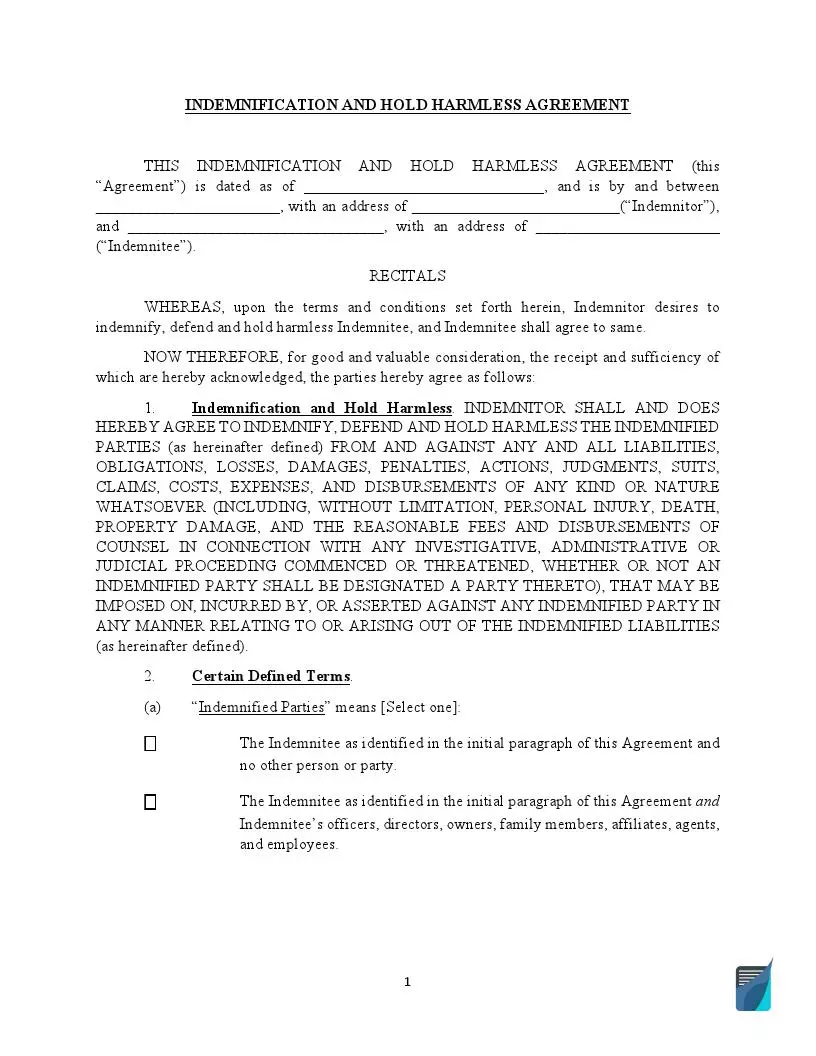
A hold harmless agreement (HHA) is essentially a liability waiver that lets one party get protection if they accidentally caused physical harm, damage, or financial loss to the other party in the contract or a third party during the cooperation relationship or service provision.
The agreement is also called an indemnity agreement or indemnification agreement, but some lawyers differentiate these two documents. We will talk about it further in the article.
The parties are called “Indemnitee” (the person or entity who is held harmless) and “Indemnifier” or “Indemnitor” (a person or entity who will be providing agreed protections).
Hold harmless agreement can be one of two types:
Hold harmless agreement is an essential document for any business that conducts physical activity. It can be applied to both customers and employees and helps a business secure itself from possible lawsuits.

Create a free Hold Harmless Agreement online in under 5 minutes!
Build Your Document
Answer a few simple questions to make your document in minutes
Save progress and finish on any device, download and print anytime
Your valid, lawyer-approved document is ready
. or download your Hold Harmless Agreement Template as a PDF file Create a free Hold Harmless Agreement online in under 5 minutes! Table of ContentsIt is a necessary element of most waivers used by industries where a certain degree of safety and health or financial risk is present.
Here are some of the most common scenarios when a hold harmless agreement needs to be signed.
In fitness gyms, clients are usually asked to sign a hold harmless agreement (as a separate agreement or as a clause of a broader contract). This makes the gym, the Indemnitee, not liable for any harm visitors may do to themselves when working out on its territory.
Or, for instance, organizers of marathons ask their participants to sign a release of liability agreement to secure themselves from potential lawsuits in case participants get injured when taking part in the sports activity.
It is very common for landlords to include a hold harmless clause in the rental agreement that would indemnify them if the renter injures themselves in or close to the rental unit. The clause might also free the landlord from any liability in case the renter gets burglarized.
The same applies to car rental businesses. The car company will most likely want renters to sign HHA to avoid possible lawsuits against them in case there is an accident involving the rental car.
Hold harmless agreements are widely used in this field. For example, when ordering house remodeling services, the owner of the building might want to protect themselves from liability if the worker hurts themselves while being on their property. HHA can be mutual if the worker wants to protect themselves too, for example should the owner’s pet wander in the construction area and accidentally injure itself.
Companies that provide various amusements such as balloon rides, shark feeding, rope jumping, white water rafting, or ATV rides, usually require a client to sign HHA to make them aware of the risks involved.
There are 3 forms of indemnity based on the breadth and scope of liabilities transferred to another party in the contract. They are most often used in contracts in the construction industry.
Such a provision states that regardless of the type of fault, the Indemnitor takes an unqualified obligation to hold harmless the Indemnitee for any liability that arises from the agreement. The entire risk of loss is shifted to the Indemnitor even if the other party is solely at fault for the losses.
However, not all states allow using this form as a lot of them have enacted anti-indemnity statutes. This way, they limit the breadth and scope of indemnity clauses that parties can include in their contracts. An improper level of indemnity can lead to the clause being void.
Under an intermediate form of the indemnity provision (which is the most common form in the construction industry), the Indemnitor is held liable for all losses arising out of the agreement if both parties are in one way or another at fault. The indemnifying party might be just 1% at fault but the Indemnitee still receives 100% indemnity.
The Indemnitee is not held harmless only in cases where the accident or damage was a result of their sole negligence.
Such a form allows limiting the Indemnitor’s liability only to the extent of the Indemnitor’s fault. It is usually calculated as a percentage of their fault.
It is easy to not notice the difference between HHA and similar agreements considering that one way or another they have to do with liability release. That’s why we are going to remove some ambiguity and clarify why the following documents slightly differ.
In an indemnity agreement, one party agrees to protect another party from liability. For instance, with the use of an indemnity agreement, a renter of land can protect the landowner against any harm that might occur during the use of such land for a business meeting.
Essentially, both indemnity agreement and HHA have a similar purpose of shifting the liability to one of the parties (or both of the agreement is mutual). The difference between those two is debatable, but some law experts assume the major difference is that in HAA, both liabilities and losses can be covered, while an indemnity agreement covers losses in the first place.
In practice, these two clauses are often used together in contracts.
While HHA is about releasing from responsibility, a waiver of liability implies giving up a legal right. For example, a person or entity to whom a debt is owed can waive a late penalty right if payment is overdue.
Those two clauses are usually kept separately in an agreement as they have significant differences in coverage and scope of liability.
In a policy agreement, the risk is transferred from the policyholder to the insurance company in exchange for a premium.
In the case of HHA, the risk is transferred through a non-insurance agreement, that is, not in exchange for payment. It does not transfer the cause of the liability but does transfer the financial responsibility for the liability, which is why the indemnitee is essentially not relieved from liability.
Crafting a hold harmless agreement is not a difficult process. Here are the common steps to drafting a legally binding hold harmless agreement.
First and foremost, the agreement should include details on:
One of the most important things is making sure the agreement has the correct legal language that covers the protections the Indemnitee and Indemnifier want. A free hold harmless agreement template can be easily found online, but it is always recommended to seek an attorney’s legal advice first.
When it comes to wording, a hold harmless agreement varies from industry to industry. But since it exists to shift responsibility, the essence regardless of the wording will be the same.
Let’s take an example of a declaration that can be signed if a person is going to become a participant in a marathon.
“I desire to take part in the marathon at my own risk. All necessary precautions will be taken by me, and I understand full personal responsibility to ensure all reasonably foreseeable safety requirements are met to my personal satisfaction before I take active participation in the marathon. I state I am in good health, physical condition to engage in this activity, and have no known medical limitations which could foreseeable threaten my safety and life during such participation or be worsened by it. As a condition precedent to me getting permission to engage or participate in the marathon, I personally hereby forever indemnify and hold harmless the United States, its agents, officers, and employees, from any cause of action, including personal injury, illness, death, and property damage, costs, charges, claims, demands and liabilities of whatever kind, name or nature in any manner that arise out of or in connection with my participation in the abovementioned sports activity.”
Best hold harmless clauses are direct and simple. Even if the contract is long, you should make this clause visible to the signee. Don’t bury it in a longer paragraph or hide it at the very end of the contract.
It is easy to find a free hold harmless agreement template on the internet. But every sort of business relations requires an individual approach, and your document should adhere to your state’s laws.
To not get lost in legalese, use our online document builder to make sure you haven’t missed anything out in your customized hold harmless agreement.
Choosing proper legalese is not enough to write a good hold harmless agreement. Before putting it into use by your business, you should be confident that it complies with all laws of your state.
Local laws concerning the liability of the parties in the contract are what you need to learn. You should also learn what protections are usually offered to customers by businesses like yours.
The quicker and easiest way to do this is using a lawyer’s legal advice as they are the ones who have access to the most recent versions of laws. They will suggest the right language to use and tell you about the legal responsibilities of your business.
As a result, you will be sure that the hold harmless agreement is valid and offers your business full legal protection.

Step 1
First, information about the Indemnitee and the Indemnifier or people who will sign the document on their behalf should be added. It includes names and addresses and the effective date of the agreement.
Step 2
Second, the agreement should include recitals and definitions. They will help avoid ambiguity which will make for better cooperation between the Indemnitee and Indemnifier. Here, mention what purpose the agreement is being created for.
Step 3
Now it’s time for the “Indemnification” section. It should include cases when the Indemnitee is released from liability and exceptions, that is, certain circumstances when Indemnitee cannot hold harmless. Such exceptions can include claims caused by the negligence of the Indemnitee, or if they do not act in good faith, or were knowingly fraudulent or deliberately dishonest.
Step 4
Add miscellaneous provisions. They might include:
Step 5
Sign the agreement or give it to representatives for signing. Having the agreement signed is technically the only requirement for the document to be binding on two parties. However, if the agreement is signed by an authorized representative, a notarized letter of authorization signed by the party represented might be needed.
All parties that sign the agreement should get its copies. It is always a good idea to keep both a physical and an electronic copy of the agreement.
If you need to get a sample hold harmless agreement fast and easy, use our free templates. Or, if you want to get a customized legally binding document, use our document builder. There, you will be asked to provide basic information on the state, parties, and the protections provided. Then, you can easily download and print agreement templates and give a copy to the other party.
Published: Jul 12, 2022
With over 25 years of experience as a business and transactional attorney, Jennifer has mastered the craft of closing highly successful deals for her clients. Through her wide-ranging expertise in commercial contracts, real estate transactions, M&A and corporate law, Jennifer secures results that are second-to-none.